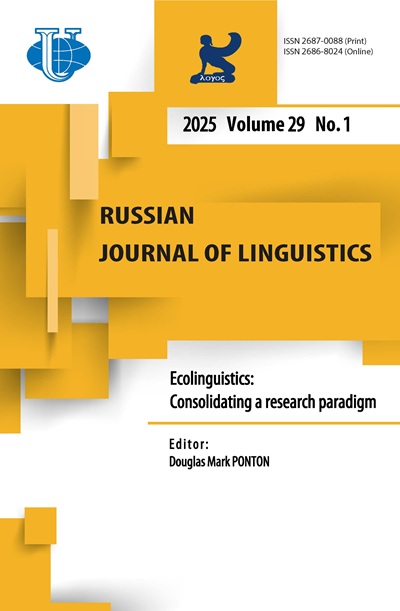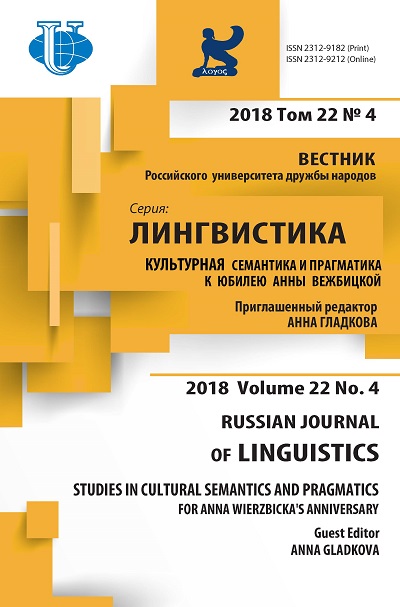Лексикографический подход к изучению кополисемических отношений
- Авторы: Польгер А.1
-
Учреждения:
- Лотарингский университет, CNRS, ATILF
- Выпуск: Том 22, № 4 (2018): Культурная семантика и прагматика: к юбилею Анны Вежбицкой
- Страницы: 788-820
- Раздел: КУЛЬТУРНАЯ СЕМАНТИКА И ПРАГМАТИКА
- URL: https://journals.rudn.ru/linguistics/article/view/20165
- DOI: https://doi.org/10.22363/2312-9182-2018-22-4-788-820
Цитировать
Полный текст
Аннотация
Понятие лексической полисемии рассматривается c разных точек зрения в теоретической лексикологии, практической лексикографии и при так называемом когнитивном подходе к изучению лексики. В данной статье полисемия определяется как свойство вокабулы (заглавного слова словарной статьи) объединять несколько значений слова, в то время как моносемия рассматривается как противоположное этому свойство. В основе полисемии лежат отношения между лексическими единицами в рамках одной вокабулы. Такие отношения мы называем кополисемией. В статье обосновывается необходимость изучения данного явления, подчеркивается, что понятие кополисемии важно не только для объяснения хорошо известного понятия регулярной полисемии, но и для моделирования полисемической структуры вокабул, понимания того, как эта структура влияет на изменения в лексике, освоение новой лексики и т. д. Изучение кополисемии должно основываться на тщательном изучении лексических данных. В данной статье мы представляем последние результаты исследования кополисемии во французском языке, которое позволило нам системно выявить модели кополисемии (на которых, как нам кажется, основана регулярная полисемия) и формально описать полисемические структуры нескольких тысяч французских вокабул. Эта практическая работа является частью широкомасштабного лексикографического проекта по созданию Французской лексической Сети (fr-LN). Несмотря на то, что данное исследование провидится на материале французской лексики, такой подход моделирования полисемии может быть применен к естественным языкам в целом.
Об авторах
Ален Польгер
Лотарингский университет, CNRS, ATILF
Email: alain.polguere@univ-lorraine.fr
Ален Польгер защитил докторскую диссертацию в Монреальском университете (Монреаль, Канада) по семантико-синтаксическому взаимодействию в создании компьютерных текстов. Академическую карьеру начал в Национальном университете Сингапура (1991-1995), затем работал в Монреальском университете (1995-2010). 44 avenue de la Libération, BP 30687, 54063 Nancy Cedex, France
Список литературы
- Apresjan, Juri D. (1974). Regular Polysemy. Linguistics 142, 5-32.
- Barque, Lucie, Haas, Pauline, Huyghe, Richard (2018). Polysémie régulière et néologie sémantique. Constitution d’une ressource pour l’étude des sens nouveaux. Neologica 12, 91-108.
- Bréal, Michel (1897). Essai de sémantique: science des significations. Paris: Hachette.
- Béjoint, Henri (1990). Monosemy and the Dictionary. In Tamás Magay and Judit Zigány (eds.): BudaLEX’88 Proceedings. Papers from the 3rd International EURALEX Congress, Budapest: Akadémiai Kiadó, 13-26.
- Courbon, Bruno (2015). Sur l’histoire du terme polysémie. 1: Genèse(s) du concept. Langues et linguistique 35, 1-23.
- Cruse, D. Alan (1995). Polysemy and Related Phenomena from a Cognitive Linguistic Viewpoint. In Patrick Saint-Dizier and Evelyn Viegas (eds.): Computational Lexical Semantics. Cambridge et al.: Cambridge University Press, 33-49.
- Falkum, Ingrid Lossius, Vicente, Agustin (2015). Polysemy: Current perspectives and approaches. Lingua 157, 1-16.
- Fellbaum, Christiane D. (ed.) (1998). WordNet: An Electronic Lexical Database. Cambridge, MA: The MIT Press.
- Gader Nabil, Ollinger, Sandrine, Polguère Alain (2014). One Lexicon, Two Structures: So What Gives? In Heili Orav, Christiane D. Fellbaum and Piek Vossen (eds.): Proceedings of the Seventh Global Wordnet Conference (GWC2014), Global WordNet Association, Tartu, 163-171.
- Geeraerts, Dirk (1994). Polysemy. In Ron E. Asher and James M. Y. Simpson (eds.): Encyclopedia of Language and Linguistics. Oxford, UK: Pergamon, 3227-3228.
- Goddard, Cliff (2000). Polysemy. A Problem of Definition. In Yael Ravin and Claudia Leacock (eds.): Polysemy: Theoretical and Computational Approaches. Oxford: Oxford University Press, 129-151.
- Goddard, Cliff (2011). Semantic Analysis. A Practical Introduction. 2nd edition, Oxford Textbooks in Linguistics. Oxford, UK: Oxford University Press.
- Goddard, Cliff, Wierzbicka, Anna (eds.) (2002). Meaning and Universal Grammar: Theory and Empirical Findings. Volumes I, II. Studies in Language Companion Series 60. Amsterdam/ Philadelphia: John Benjamins.
- Goddard, Cliff, Wierzbicka, Anna (2014). Words and Meanings: Lexical Semantics Across Domains, Languages, and Cultures. Oxford UK: Oxford University Press.
- Gries, Stefan Th. (2015). Polysemy. In Ewa Dąbrowska and Dagmar S. Divjak (eds.): Handbook of Cognitive Linguistics. Handbücher zur Sprach- und Kommunikationswissenschaft / Handbooks of Linguistics and Communication Science (HSK) 39. Berlin/Boston: De Gruyter Mouton, 472-490.
- Hanks, Patrick (2013). Lexical Analysis. Norms and Exploitations. Cambridge, MA/London, UK: The MIT Press.
- Hénault, Christine (2008). Eating Beyond Certainties. In Vanhove (2008), 291-301.
- Ingrosso, Francesca, Polguère, Alain (2015). How Terms Meet in Small-World Lexical Networks: The Case of Chemistry Terminology. Proceedings of the 11th International Conference on Terminology and Artificial Intelligence (TIA 2015), Granada, 167-171.
- Krylosova, Svetlana (2017). Du projet d’élaboration d’un Réseau lexical du russe (RL-ru). Karpovskie naučnye čtenija 11(1), 243-246.
- Ludlow, Peter (2014). Living Words. Meaning Underdetermination and the Dynamic Lexicon. Oxford, UK: Oxford University Press.
- Lux-Pogodalla, Veronika, Polguère, Alain (2011). Construction of a French Lexical Network: Methodological Issues. Proceedings of the First International Workshop on Lexical Resources, WoLeR 2011. An ESSLLI 2011 Workshop, Ljubljana, 54-61.
- Mel’čuk, Igor (1989). Semantic Primitives from the Viewpoint of the Meaning-Text Linguistic Theory. Quaderni di Semantica 10(1), 65-102.
- Mel’čuk, Igor (1996). Lexical Functions: A Tool for the Description of Lexical Relations in the Lexi¬con. In Leo Wanner (ed.): Lexical Functions in Lexicography and Natural Language Processing. Language Companion Series 31, Amsterdam/Philadelphia: John Benjamins, 37-102.
- Mel’čuk, Igor (2006a). Explanatory Combinatorial Dictionary. In Giandomenico Sica (ed.): Open Problems in Linguistics and Lexicography. Monza: Polimetrica, 225-355.
- Mel’čuk, Igor (2006b). Aspects of the Theory of Morphology. Trends in Linguistics. Studies and Monographs 146. Berlin & New York: Mouton de Gruyter.
- Mel’čuk, Igor (2007). Lexical Functions. In Harald Burger, Dmitrij Dobrovol´skij, Peter Kuhn and Neal Norrrick (eds.): Phraseologie / Phraseology: Ein Internationales Handbuch Zeit-genössischer Forschung / an International Handbook of Contemporary Research. Berlin/ New York: Walter de Gruyter, 119-131.
- Mel’čuk, Igor (2013). Semantics: From Meaning to Text. Volume 2. Studies in Language Companion Series 135. Amsterdam/Philadelphia: John Benjamins.
- Mel’čuk, Igor, Clas, André, Polguère, Alain (1995). Introduction à la lexicologie explicative et combinatoire. Paris/Louvain-la-Neuve: Duculot.
- Mel’čuk, Igor et al. (1984, 1988, 1992, 1999). Dictionnaire explicatif et combinatoire du français contemporain. Recherches lexico-sémantiques I, II, III, IV. Montreal: Les Presses de l’Université de Montréal.
- Mel’čuk, Igor, Polguère, Alain (In press). Theory and Practice of Lexicographic Definition. Journal of Cognitive Science.
- Mel’čuk, Igor, Zholkovsky, Alexander (1984). Explanatory Combinatorial Dictionary of Modern Russian. Semantico-syntactic Studies of Russian Vocabulary. Vienna: Wiener Slawistischer Almanach.
- Navigli, Roberto, Ponzetto, Simone Paolo (2012). BabelNet: The Automatic Construction, Evaluation and Application of a Wide-Coverage Multilingual Semantic Network. Artificial Intelligence 193, 217-250.
- Picoche, Jacqueline (1993) La cohérence des polysèmes, un outil pour débloquer l’enseignement du vocabulaire. Repères 8, 11-28.
- Polguère, Alain (2009) Lexical Systems: Graph Models of Natural Language Lexicons. Language Resources and Evaluation 43(1), 41-55.
- Polguère, Alain (2014). From Writing Dictionaries to Weaving Lexical Networks. International Journal of Lexicography 27(4), 396-418.
- Polguère, Alain (2015). Lexical Contextualism: The Abélard Syndrome. In Núria Gala, Reinhard Rapp and Gemma Bel-Enguix (eds.): Language Production, Cognition, and the Lexicon. Text, Speech and Language Technology 48, Cham Heidelberg New York Dordrecht London: Springer, 53-73.
- Polguère, Alain (2016a). Lexicologie et sémantique lexicale. Notions fondamentales. 3rd edition, Montreal: Les Presses de l’Université de Montréal.
- Polguère, Alain (2016b). La question de la géométrie du lexique. SHS Web of Conferences 27, 01002 [F. Neveu et al.: Proceedings of the “5e Congrès Mondial de Linguistique Française (CMLF 2016)”, Tours].
- Sigman, Mariano, Cecchi, Guillermo A. (2002). Global Organization of the Wordnet Lexicon. Proceedings of the National Academy of Sciences of the United States of America 99(3), 1742-1747.
- Traugott, Elizabeth Closs, Dasher, Richard B. (2001). Regularity in Semantic Change. Cambridge Studies in Linguistics 97, Cambridge UK: Cambridge University Press.
- Ullmann, Stephen (1959). Sémantique et étymologie. Cahiers de l’Association internationale des études françaises 11, 323-335.
- Vanhove, Martine (ed.) (2008). From Polysemy to Semantic Change. Studies in Language Companion Series 106. Amsterdam/Philadelphia: John Benjamins.
- Watts, Duncan J., Strogatz, Steven H. (1998). Collective dynamics of ‘small-world’ networks. Nature 393, 440-442.
- Wierzbicka, Anna (1985). Lexicography and Conceptual Analysis. Ann Arbor, MI: Karoma.
- Wierzbicka, Anna (1987). English Speech Act Verbs: A semantic dictionary. Sydney: Academic Press.
- Wierzbicka, Anna (1992). Back to Definitions: Cognition, Semantics, and Lexicography. Lexico¬graphica 8, 146-174.
- Wierzbicka, Anna (1996). Semantics: Primes and Universals. Oxford, UK: Oxford University Press.
- Zalizniak, Anna A. (2007). The Phenomenon of Polysemy and Ways to Describe It. In Marina Rakova, Gergely Pethő and Csilla Rákos (eds.): The Cognitive Basis of Polysemy. New Sources of Evidence for Theories of Word Meaning. Metalinguistica 19, Frankfurt am Main et al.: Peter Lang, 93-121.

















